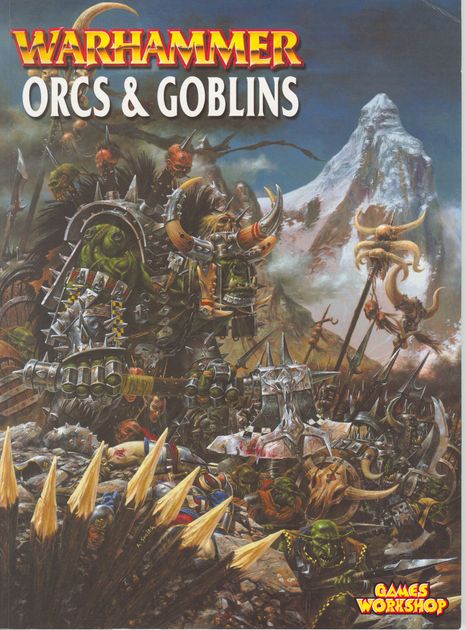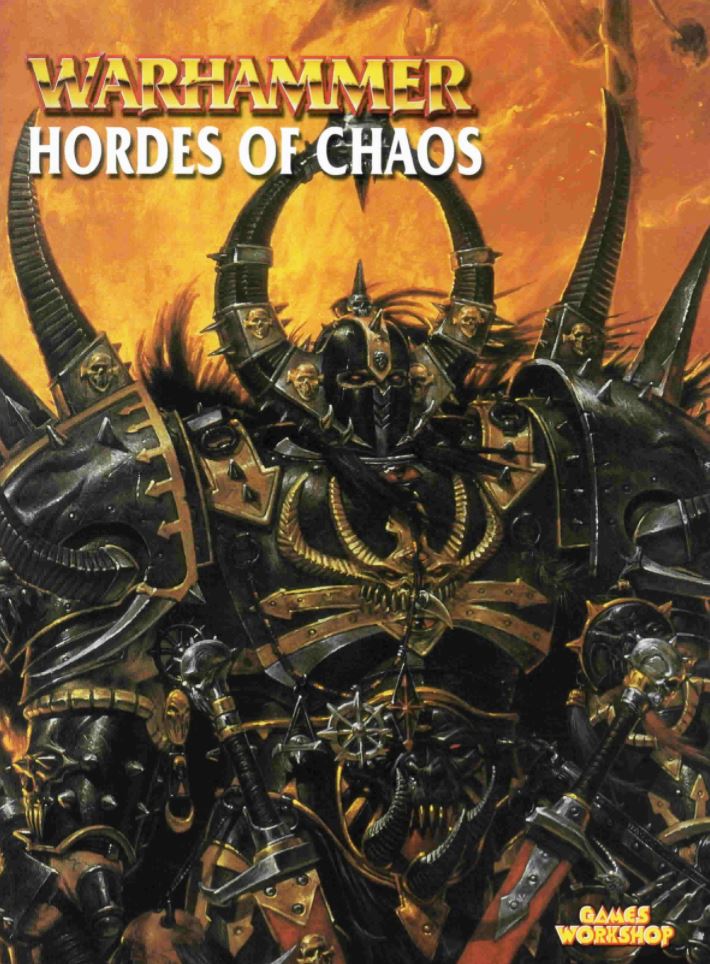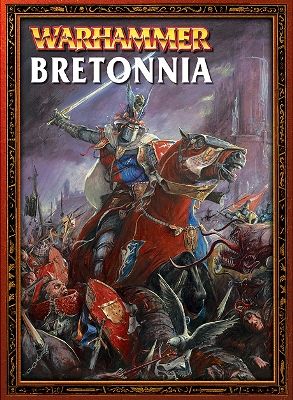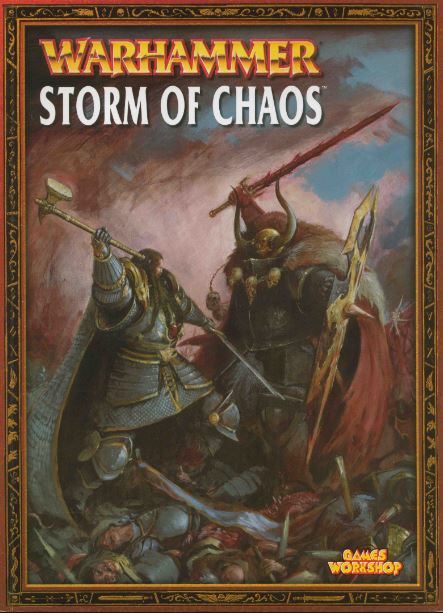6th Edition Warhammer was probably peak Warhammer Fantasy for me. I’d started getting interested in the game during the waning days of 5th edition and took the plunge with the launch of 6th edition back in 2,000. I picked up the starter box with the intention of building up the Orcs. I certainly built them, but painting was more hit and miss. Many of the Orcs from the 6th edition starter set featured in last year’s clearout of old Orc minis.
6th edition saw a lot of changes in the game. It introduced more restrictions in list building, with units separated out into the categories of Lord, Heroes, Core, Special, and Rare, with restrictions of how much of each you could bring along. The game was refocused from 5th edition’s overreliance on heroes (Herohammer!), to a more infantry-centric approach. The magic system was changed significantly and was a lot more straightforward. The game just worked really well.
It also had some really great army books. Let’s look at some of the highlights.
Where we Began: Ravening Hordes

Because of just how different 6th edition was to what had come before, army books were not transferrable between editions. Games Workshop’s answer to this was the Ravening Hordes booklet, named for a previous compilation of army lists. For a new player who was just entering the hobby at the time that this booklet was released, this was actually pretty great. The booklet contained army lists for all of the factions of the time, except for the Dogs of War, and this was useful in a couple of different ways. Not only did you have your own army list in there, but you also had access to all the others. You knew what you were up against, could compare units, and generally be more aware of what was in the game. Again, this is particularly good for a new player still learning the game.
It took a long time for all of the books to roll out. Until your book arrived, you were using your Ravening Hordes list, so this booklet was with us for quite a while. Hell, if you were a Chaos Dwarf player, you’re still using it, I’m sure!
5. Orcs and Goblins

My first love and my first army. I won’t lie, this book might be here largely for sentimental reasons, but it was an absolute cracker. For one thing, because there were so many different Orc and Goblin unit variants, the list seemed so expansive. I feel that it was slightly lacking in special characters, but those it did have were fantastic. Namely, these were Wurrzag, the Savage Orc Shaman, and the biggest boss himself, Grimgor Ironhide. I did love the sheer variety in this book, and had a good few thousand points of Greenskins.
4. Vampire Counts

5th edition was the first iteration of Warhammer to spin the Vampire Counts out into their own faction. Previously, they had just been part of the generic ‘Undead’ faction. The revamp of the Vampire Count line that accompanied this book was fantastic. I loved that each of the vampiric bloodlines had their own play style and their own distinctive aesthetic. My favourites were probably the Necrarchs and the Lahmians. Clearly, I still like the Lahmians! My favourite character from the book was Zaccharius the Everliving, though I never owned the model. I’d love to see him and the rest of the Necrarchs make a comeback in a future Soulblight Gravelords book. The appendices were pretty cool, allowing players to field an alternative list, focused on specific bloodlines. This was back when GW put semi-official rules into their books; like flavourful lists that you were supposed to ask your opponent to approve before you played.
3. Hordes of Chaos

One of the truly defining books of this edition, Hordes of Chaos was interesting on a few fronts. The biggest factor was the fundamental changes to list building that it introduced. At the time, units were split into Lord, Hero, Core, Special, and Rare units. Unlike most books, this one did not define Core and Special. Instead, there were Mortal and Daemonic units. If your general was a mortal, your mortal units became Core, and daemonic units were Special. With a Daemonic general, this was reversed. In the Rare category, we had Chaos Spawn and Dogs of War (mercenaries). This was so cool, and it allowed for interesting, mixed-Chaos armies. In terms of special characters, we had Archaon (pre-End Times and AoS massiveness) and Galrauch. Galrauch was a twin-headed Chaos Dragon. He was (they were?) an interesting character, but I really disliked the model. It’s a pity, because the rest of the range looked pretty great.
2. Beasts of Chaos

Okay, so, this book could act as a standalone book for the Beasts of Chaos and, in that regard, it was a really cool book. What made it even better, is that could also be used in conjunction with the Hordes of Chaos book, using the same conditional army selection rules. This means you could incorporate Mortal and Daemons into your Beasts army, or incorporate Beasts into your Mortal or Daemon armies. That’s just fantastic. I really liked the revamp that the Beastmen got for 6th edition, and I especially loved their special characters. They had three, the most interesting of which was the foul and corrupting Murghur. I’d love them to bring him back as a much bigger, cooler character in Age of Sigmar.
1. Bretonnia

Okay, so, the Bretonnians waited a long time for their book and, like most of the armies in 6th edition, got a complete range refresh when it came out. The army was quite different, consisting mostly of knights with peasant militia as supporting units. The lance formation was a big part of what made the army unique, giving Bretonnian cavalry a unique way to field their units that allowed more knights to get into combat. Despite having four units of knights, each one really felt different from the others. The coolest thing about the book, of course, was the graphic design. The book was full of unique layouts, themed around heraldry. The army pictures were also more elaborately set, with columns of knights emerging from castles, and characters fighting dragons. The painting guides were also really well-presented.
Special Mention: Storm of Chaos

Although not an army book per se, Storm of Chaos does have 10 army lists in it. Some, like the Bretonnian Errantry War, made slight tweaks to army selection, unit rules, and/or magic items. Others were more in-depth. The Daemonic Legions list builds on the Daemons in the Hordes of Chaos book, adding a ton of units. It really laid the foundation for the range of Daemonic units that we have today. I also really love the Cult of Slaanesh army. This one saw a cross between some cool Slaaneshi-themed Chaos units and the Dark Elves as led by Morathi. Again, this kind of acts as a precursor to an existing army; this time the Daughters of Khaine. All the lists are cool. The campaign itself was a lot of fun as well, and it moved the story of the Old World on in a really cool way. The end of the campaign turned out to be a wee bit anti-climactic, but it’s still great. Although, again, not an army book, it’s still my favourite book for this edition of Warhammer.


6th was such a great edition. I’m really happy to see Beasts got mentioned in your list because I’ve always loved the lore and “scary things in the creepy woods” narrative. I have a huge Beastmen army on square bases that part of me knows I should put on round bases, but the other part loves the rank and file mob look.
LikeLiked by 2 people
Love the square base look, so fitting for WHFB.
LikeLiked by 1 person
6th Edition, very fond memories and pretty much the last time I played War Hammer.
LikeLiked by 1 person
Never actually played Warhammer, more of a Blood Bowl goon. But I do really like the cover art on those first four books.
LikeLiked by 1 person
Oh, I love Blood Bowl. Not had a game of it in a few years, though.
LikeLiked by 2 people
It’s a fun game, and the Blood Bowl 7s rules are great if you want something a little quicker (about half the players on the field, rerolls are few to none, etc.).
LikeLike